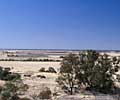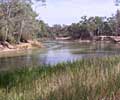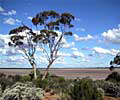
 |
|
||
Terrestrial Biodiversity
|
||||||||||||||||||||
 |
 |
 |
 |
 |
Understanding the functional diversity of communities is a crucial component of whole-system analyses of biodiversity and its role in ecological patterns and processes. In this study we will concentrate on the identification of species level functional traits. Ecosystem functions (e.g. nutrient cycling, formation of biopores and leaching capability) are moderated by the functional attributes of species in a community. To understand how an ecosystem will function, and its ability to provide crucial ecosystem services as well as its capacity to respond to environmental changes, we need to understand both the functional and species diversity of the community. Knowledge about the functional attributes of the species that comprise an ecosystem is crucial to achieving specific management outcomes (e.g. for water benefits, biodiversity protection; see Table 1). This is particularly the case since the question of how these different attributes of community structure relate to community health and sustainability is still unresolved.
|
Table 1. Key questions relating to understanding relationships between community structure, biodiversity and representation in functional groups. |
|
|
What do we want to know? |
Why? |
|
What are the characteristics of a self-regenerating functioning ecosystem? |
|
|
To what extent and how have past modern human activities changed the 'natural health' of an ecosystem? |
|
|
How can we predict decreasing functionality in terms of crucial ecosystem services? |
|
|
Can we predict the responses of ecosystems and their component species to environmental change (including deliberate management)? |
|
|
How feasible is it to try to 'restore' degraded ecosystems? |
|
Complementary to the broader diversity analyses being planned for C4.P4, this study aims to explicitly characterise and quantify the relationships between biodiversity and ecosystem function, drawing on the extensive biological collections residing within CSIRO. Biological collections themselves present a range of characteristics which can be harnessed to predict functional attributes from specimen attributes. In particular, this study will establish functional attributes for a selected list of plant, insect and vertebrate taxa targeted because of their anticipated key roles in riparian ecosystems.
Plants – During the past few years the ecological and vegetation science literature has supported a wide range of studies aiming to understand ecosystem function and the behaviour of plant functional types in relation to environmental characteristics (Semenova & van der Maarel 2000). Plant function is usually described through plant attributes or traits, e.g. ‘hairy leaves’ in sense of Landsberg et al. (1999) or the ‘vital attributes’ system of Noble & Slatyer (1980). The environment in these situations may be explained either in a broad sense (e.g. climate and global change) or more specifically in terms of local conditions (e.g. disturbance or fire regimes).
The search for plant functional types represents a long standing desire of ecologists to seek simplified explanatory variables for understanding patterns in the richness of plants and the complexity of ecosystems. As McIntyre et al. (1999) point out the search is pursued for a range of purposes - e.g. the systematic analysis of ecosystem function and its dependence on community structure, or for improved assessment of ecosystem sensitivity, and ability to respond to changes in the environment.
McIntyre et al. (1999) call for simplified (functional) species classifications for use in functional ecosystem studies, on the premise that the fewer groups used the greater the chance that broad patterns can be discerned. However, it is likely that the degree to which simplified functional classifications can provide meaningful conclusions will be scale-dependent. Broad categories are likely to be most useful when considering patterns over large geographic areas, while more narrowly defined descriptions may be necessary at more local scales or within particular types of ecosystems (e.g. floodplain vegetation). Ideally it would be instructive to have a system of environmental constraints in some sort of hierarchy from major constraints operating at the global level down to constraints operating at the regional and local level. Grime (1998) expressed this view in terms of functional types which can be considered at a hierarchy of scales. At the regional and local level it may be pragmatic to restrict the species considered to include only dominant species or those presumed to have a critical function in the ecosystem.
Animals – Integral to the functional diversity of plant communities are the other organisms that inhabit them, and in many cases supply vital ecosystem services. Such services can include pollination, decomposition, soil conditioning and nitrogen fixation. While plant ecologists have spent much effort in the development and verification of systems for functional classification of plants, the same is not true for insect ecology. Although functional groups are often used to describe insect community structure, these groupings tend to be ad hoc, or specific to only certain orders of insects. They usually focus on feeding behaviour alone, and often require pre-existing knowledge of species biology. Some other classifications are based on how organisms respond to an environmental attribute (e.g. "species B is known to increase with increasing disturbance" (Basset et al. 2004)), which can be useful in particular studies, but is not easily generalisable. For these reasons there is no existing functional group classification that can be usefully applied to insects for the purposes of this project. We suggest, however, that research towards developing a system for predictive functional grouping would be a significant advance in natural resource management (NRM) science. This need for better systems of functional description is now widely recognized (Naeem and Wright 2003).
Insect ecologists struggle with the immense diversity of species about which so little is known, and they struggle with the propensity for insect communities to change so much over quite short distances (i.e. beta diversity is high). This complexity makes the need for functional grouping more intense. However, insects have the potential to be powerful indicators of environmental change, because many groups are easy to sample, and because of their mobility and usually short life cycles, insects are expected to respond to change quite quickly. For example, several recent studies have pointed to the relative salinity tolerance of a wide variety of invertebrates, and suggested that rising salinity levels in rivers could adversely affect invertebrate fauna and ecosystem processes (Bailey et al., 2002; Chessman, 2003; Kefford et al., 2003; 2004). Other authors have suggested that macroinvertebrates can be effective monitors of water quality (Watson, 1982; Water and Rivers Commission, 1996; Minnesota Pollution Control Agency, 2004).
Disturbance dynamics in natural and managed ecosystems have recently received increased attention in empirical, as well as theoretical studies. It has long been recognized that diversity (or complexity) is closely related to disturbance at several levels of scale. Roxburgh et al. (2004) recently examined further the mechanisms underlying the intermediate disturbance hypothesis, as an explanation for the coexistence of species in ecological communities, relating disturbance levels to community diversity. These underlying mechanisms are defined by the various ways in which species differ in their response to disturbance-induced spatial and temporal variability in resources and environmental conditions. From the point of view of ecological dynamics the ability to address critical issues of diversity therefore depends on our ability to understand disturbance and the role it plays in maintaining biodiverse functional communities. Investigating disturbance requires the identification of plant functional types that are directly related to the disturbance regime combined with direct experimental manipulations to identify causal relationships.
In considering environmental constraints operating on species groups Grubb (1998) proposed three different stress-tolerating strategies relating to resource limitations:
The nature of the relationship between functional attributes and disturbance is dependent on whether the agent of disturbance is abiotic or biotic. Abiotic disturbances, such as wind, fire, flooding regimes, salinity, stimulate different responses from biotic disturbances, such as insect attacks, parasitism, grazing or browsing. Further variation may be related to frequency and intensity of the disturbance agent, and the spatial scale (i.e. within-population to broad geographic regions) over which it is operating.
In the case of the immense invertebrate diversity we will first consider whether we can use fundamental insect traits in order to classify insect functional groups that allow us to make meaningful predictions about response to environmental change, risk of extinction, risk of invasiveness, and so on. The aim is to make useful predictions on the basis of collected specimens, even if we have no prior knowledge of the organism’s biology. The way to do this is to understand and interpret major patterns in function, morphology and ecology of known species. A predictive multi-trait model might include familiar traits such as body size, mouthpart design and size of flight muscle, but might also include new approaches, such as evaluation of the nitrogen isotope ratio of the tissue to predict trophic position (e.g. Davidson et al. 2003). Although functional classification tries to capture elements of species’ biology that are not described by taxonomy alone, phylogenetic information might still be an essential input into a multi-trait model.
Certain functional types of species will have a disproportionate effect on the ecosystem. For example, social insects such as termites probably have a major role in nutrient cycling, soil condition, infiltration, etc. Deeper rooted trees or those with high intrinsic transpiration rates pump greater amounts of water and thus contribute more to lowering the water table. Understanding the functional attributes of a species or species groups (or types) enables far greater predictive power to anticipate responses to environmental constraints and adaptive management strategies such as changes in environmental flows.
Achieving the goals of this study requires development of new schemes of functional classification that move beyond current classifications and are tailored to suit the local situations. Through the development of a rigorous expert system we will build an attribute database for key sets of riparian and wetland taxa. By examining the biology of well studied groups of species we will develop trait-based predictive schemes of species function that are relevant to the ecosystem services we need to manage.
The initial phase of the project has involved the selection of a number of species believed to play a key role in the functioning of the riparian, floodplain and wetland ecosystems of the Murray River system (see Biological Data Audit for the total list of target taxa). The available information from the specimen collections and literature relating to 10 species or higher level taxa has been entered into an attribute database structure, and from that database a basic collation and description of the attributes for each species is included here. The species chosen to profile initially play different roles in the ecosystem and have varying amounts of information available.
At this stage the attribute database is a simple structure with different characteristics for plants, invertebrates and the vertebrates. The fields (attributes) included for each group of organisms is provided.
It is anticipated that the development of the attribute database for key riparian taxa will be taken to a more rule-based expert system from which ready classifications of functional attributes could be extracted. This will require the attributes of the selected taxa to be categorized, synthesized and codified into an expert system developed for this purpose. Such a system would enable meaningful questions to be asked and information to be mined. This is seen as a major research project in itself which would require additional resources – a significant contribution could be made to the field of functional attributes for different groups of organisms, as well as advances in NRM science.
Bailey, P., Boon, P. & Morris, K. (2002) Australian Biodiversity Salt Sensitivity Database. Land & Water Australia. http://www.rivers.gov.au/research/contaminants/saltsen.htm
Basset, Y., Mavoungou, J., Mikissa, J., Missa, O., Miller, S. E., Kitching, R. L. & Alonso, A. 2004. Discriminatory power of different arthropod data sets for the biological monitoring of anthropogenic disturbance in tropical forests. Biodiversity Conservation 13: 709-732.
Chessman B (2003) SIGNAL 2 - A Scoring System for Macroinvertebrate ('Water Bugs') in Australian Rivers, Monitoring River Heath Initiative Technical Report no 31, Commonwealth of Australia, Canberra.
http://www.deh.gov.au/water/rivers/nrhp/signal/
Davidson, D. W., Cook, S. C., Snelling, R. R. & Chua, T. H. 2003. Explaining the abundance of ants in lowland tropical rainforest canopies. Science 300: 969-972.
Gitay H. & Noble, I. R. (1997) What are functional types and how should we seek them? In ‘Plant functional types: their relevance to ecosystem properties and global change’. (Eds T. M. Smith, H. H. Shugart, F. I. Woodward) pp. 3-19 (Cambridge University Press, Cambridge)
Grime, J.P. (1998) Benefits of plant diversity to ecosystems: immediate, filter and founder effects. Journal of Ecology 86, 902-910.
Grubb, P.J. (1998) A reassessment of the strategies of plants which cope with shortages of resources. Perspectives in Plant Ecology, Evolution and Systematics 1: 3-31.
Kefford, B.J., Dalton, A., Palmer, C.G. & Nugegoda, D. (2004) The salinity tolerances of eggs and hatchlings of selected aquatic macroinvertebrates in south-east Australia and South Africa. Hydrobiologia 517: 179-192.
Kefford, B.J., Papas, P.J.& Nugegoda, D. (2003) Relative salinity tolerance of macroinvertebrates from the Barwon River, Victoria, Australia. Marine and Freshwater Research 54: 755-765.
Kleyer, M. (1999) Distribution of plant functional types along gradients of disturbance intensity and resource supply in agricultural landscapes. Journal of Vegetation Science 10: 697-708.
Landsberg, J., Lavorel, S. & Stol, J. (1999) Grazing response groups among understoryplants in arid rangelands. Journal of Vegetation Science 10: 683-696.
Lavorel, S., McIntyre, S., Landsberg, J. & Forbes, T.D.A. (1997) Plant functional classifications: from general groups to specific groups based on response to disturbance. Trends in Ecology & Evolution 12: 474-478.
McIntyre, S., Diaz, S., Lavorel, S. & Wolfgang, C. (1999) Plant functional types and disturbance dynamics - introduction. Journal of Vegetation Science 10: 604-608.
Minnesota Pollution Control Agency (2004). Wetlands: Monitoring Aquatic Invertebrates. http://www.pca.state.mn.us/water/biomonitoring/bio-wetlands-invert.html
Naeem, S. & Wright, J. P. (2003) Disentangling biodiversity effects on ecosystem functioning: deriving solutions to a seemingly insurmountable problem. Ecology Letters 6: 567-579.
Noble, I.R. & Slatyer, R.O. (1980) The use of vital attributes to predict successional changes in plant communities subject to recurrent disturbances. Vegetatio 43: 5-21.
Roxburgh, S.H., Shea, K. & Wilson, J.B. (2004) The intermediate disturbance hypothesis: patch dynamics and mechanisms of species coexistence. Ecology 85: 359-371.
Semenova, G.V. & van der Maarel, E. (2000) Plant functional types - a strategic perspective., Journal of Vegetation Science 11: 917-922.
Water and Rivers Commission (1996) Macroinvertebrates & Water Quality. Water Facts 2. http://www.wrc.wa.gov.au/public/waterfacts/2_macro/WF2.pdf
Watson, J.A.L. (1982) Dragonflies in the Australian environment: taxonomy, biology and conservation Advances in Odonatology 1: 293-302.